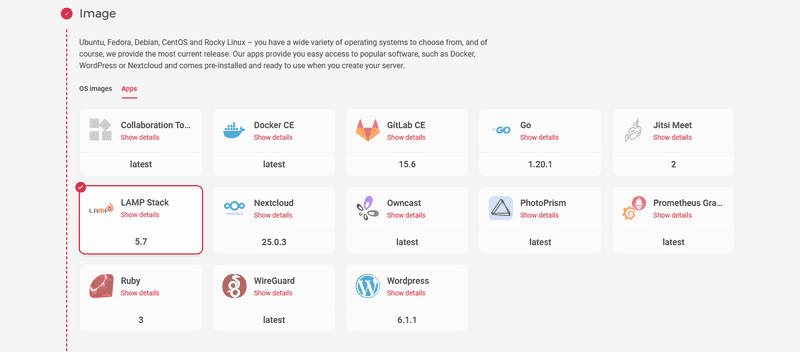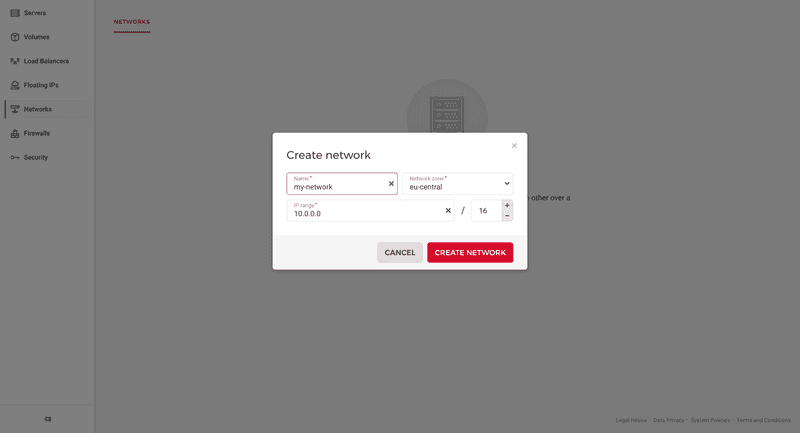Introduction
This tutorial explains how to use Hetzner Cloud Networks to access a MySQL database which is managed on one Cloud Server (MySQL server) from a second Cloud Server (MySQL client).
Prerequisites
- 1 Hetzner Cloud server with MySQL already installed
You can either install MySQL manually, or you can simply select the "LAMP Stack" app at server creation.
Step 1 - Create a private Network
Create your private Network under your Hetzner Cloud project in the region you want to use.
Remember that the default IP range is set to 10.0.0.0/16.
Step 2 - Attach the server to the Network
You can now attach the MySQL server to the new Network. You can do this by either using the Cloud Console or the hcloud tool.
hcloud server attach-to-network <your-server-name> --network <your-network-name> --ip <pvt-ip>The final part with --ip <pvt-ip> is optional. If you don't specify a specific private IP, the Hetzner Cloud system will automatically assign a free private IP for you.
Step 3 - Modify the MySQL configuration
To access MySQL from another device, you'll have to make a change in the /etc/mysql/mysql.conf.d/mysqld.cnf file.
-
Edit the
mysqld.cnffileUse the following command to open the MySQL configuration file:
nano /etc/mysql/mysql.conf.d/mysqld.cnfChange the
bind-addressparameter from127.0.0.1to0.0.0.0.
If you installed MySQL via the "LAMP Stack" app, you need to open a MySQL port (3306 by default) using the ufw tool.
If you installed MySQL manually, you need to install the firewall with this command: apt-get install ufw
-
Edit the firewall
Add a rule to the firewall to open port
3306ufw allow from 10.1.0.0/16 to any port 3306Replace
10.1.0.0/16with the IP range of the Network that you created in step 1.If you use SSH to connect to your server, you should also allow SSH connections before you enable the firewall.
ufw allow OpenSSH ufw enable
Step 4 - Create a new MySQL user
Enter the MySQL CLI as root user:
mysql -u root -pIf you used the "LAMP Stack" app, then your root password was generated by Hetzner and is stored in the
/root/.hcloud_passwordfile.
Create a new MySQL user which could be used by non-local instances.
CREATE USER '<user>'@'%' IDENTIFIED BY '<password>';
GRANT ALL PRIVILEGES ON *.* TO '<user>'@'%' WITH GRANT OPTION;
FLUSH PRIVILEGES;Also, don't forget to restart MySQL after manipulating the mysqld.cnf file. Use CTRL+D to exit the MySQL CLI and execute the following command:
service mysql restartStep 5 - Check MySQL access in the private Network
Create a new server from scratch and attach it to the same private Network.
Install MySQL client. You can have MariaDB client for example.
apt update
apt install mariadb-client -yYou now need the private IP of the first server. In the Cloud Console, you can select your project and go to the server list. From there, you can copy the private IP of this server.
Use this command to connect to the MySQL host:
mysql -h <mysql-host-private-ip> -u <user-created-above> -pThen just paste your password created for the user and voilà - you are in.
Conclusion
Here you saw just an example of how to make a database accessible in the private Network under Hetzner Cloud.
Please consider the following instructions as an example and not as best practices for the MySQL production setup.

